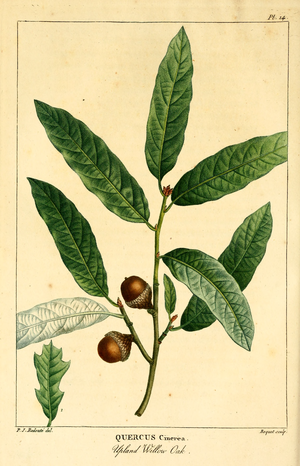Note: This is a project under development. The articles on this wiki are just being initiated and broadly incomplete. You can Help creating new pages.
Difference between revisions of "Quercus incana"
| (One intermediate revision by the same user not shown) | |||
| Line 1: | Line 1: | ||
| − | + | [[File:NAS-016f Quercus incana.png|thumb|right]] | |
| + | '''Quercus incana''' is a dciduous shrub or a small tree with a thin, irregular crown. It usually grows up to 10 metres tall. The short bole can be 70cm in diameter with a dark brown or black bark that becomes thick and corky, but is broken into square plates. The plant produces suckers and often forms thickets. | ||
==Uses== | ==Uses== | ||
| − | {{Uses|}}, {{Uses|}}, {{Uses|}}, {{Uses|}}, {{Uses|}}, {{Uses|}}, {{Uses|}}, {{Uses|}}, {{Uses| | + | {{Uses|Acute diarrhea}}, {{Uses|Dysentery}}, {{Uses|Haemorrhages}}, {{Uses|Toothache}}, {{Uses|Cuts}}, {{Uses|Burns}}, {{Uses|Various skin problems}}, {{Uses|Haemorrhoids}}, {{Uses|Anal mucosa inflammation}}.<ref name="Uses"/> |
==Parts Used== | ==Parts Used== | ||
| − | {{Parts Used| | + | {{Parts Used|Leaves}}. |
==Chemical Composition== | ==Chemical Composition== | ||
| Line 29: | Line 30: | ||
==Habit== | ==Habit== | ||
| − | {{Habit|}} | + | {{Habit|Semi-deciduous tree}} |
==Identification== | ==Identification== | ||
| Line 48: | Line 49: | ||
==Mode of Propagation== | ==Mode of Propagation== | ||
| − | {{Propagation|}} | + | {{Propagation|Seeds}} |
==How to plant/cultivate== | ==How to plant/cultivate== | ||
| − | <ref name="How to plant/cultivate"/> | + | Quercus incana is a very cold-hardy tree, tolerating temperatures down to around -25°c when dormant. It grows best in areas with hot summers.<ref name="How to plant/cultivate"/> |
==Commonly seen growing in areas== | ==Commonly seen growing in areas== | ||
| − | {{Commonly seen|}}, {{Commonly seen| | + | {{Commonly seen|Woodlands}}, {{Commonly seen|On well-drained sandy soils}}. |
==Photo Gallery== | ==Photo Gallery== | ||
<gallery class="left" caption="" widths="140px" heights="140px"> | <gallery class="left" caption="" widths="140px" heights="140px"> | ||
| − | + | File:NAS-016f Quercus incana.png | |
</gallery> | </gallery> | ||
| Line 64: | Line 65: | ||
<references> | <references> | ||
| − | <ref name="chemical composition">[ | + | <ref name="chemical composition">[Chemistry]</ref> |
| − | <ref name="Leaf">[ | + | <ref name="Leaf">[Morphology]</ref> |
| − | <ref name="How to plant/cultivate">[ | + | <ref name="How to plant/cultivate">[http://temperate.theferns.info/plant/Quercus+incana Cultivation]</ref> |
<ref name="Uses">Indian Medicinal Plants by C.P.Khare</ref> | <ref name="Uses">Indian Medicinal Plants by C.P.Khare</ref> | ||
</references> | </references> | ||
==External Links== | ==External Links== | ||
| − | * [ ] | + | * [http://www.efloras.org/florataxon.aspx?flora_id=1&taxon_id=233501048 Quercus incana on www.efloras.org] |
| − | * [ ] | + | * [https://edis.ifas.ufl.edu/fr310 Quercus incana on edis.ifas.ufl.edu] |
| − | + | ||
[[Category:Herbs]] | [[Category:Herbs]] | ||
[[Category:Pages without herbs images]] | [[Category:Pages without herbs images]] | ||
Latest revision as of 17:41, 11 June 2020
Quercus incana is a dciduous shrub or a small tree with a thin, irregular crown. It usually grows up to 10 metres tall. The short bole can be 70cm in diameter with a dark brown or black bark that becomes thick and corky, but is broken into square plates. The plant produces suckers and often forms thickets.
Uses
Acute diarrhea, Dysentery, Haemorrhages, Toothache, Cuts, Burns, Various skin problems, Haemorrhoids, Anal mucosa inflammation.[1]
Parts Used
Chemical Composition
Common names
| Language | Common name |
|---|---|
| Kannada | |
| Hindi | |
| Malayalam | |
| Tamil | |
| Telugu | |
| Marathi | |
| Gujarathi | |
| Punjabi | |
| Kashmiri | |
| Sanskrit | |
| English |
Properties
Reference: Dravya - Substance, Rasa - Taste, Guna - Qualities, Veerya - Potency, Vipaka - Post-digesion effect, Karma - Pharmacological activity, Prabhava - Therepeutics.
Dravya
Rasa
Guna
Veerya
Vipaka
Karma
Prabhava
Habit
Identification
Leaf
| Kind | Shape | Feature |
|---|---|---|
Flower
| Type | Size | Color and composition | Stamen | More information |
|---|---|---|---|---|
| {{{5}}} |
Fruit
| Type | Size | Mass | Appearance | Seeds | More information |
|---|---|---|---|---|---|
Other features
List of Ayurvedic medicine in which the herb is used
Where to get the saplings
Mode of Propagation
How to plant/cultivate
Quercus incana is a very cold-hardy tree, tolerating temperatures down to around -25°c when dormant. It grows best in areas with hot summers.[4]
Commonly seen growing in areas
Photo Gallery
References
- ↑ Indian Medicinal Plants by C.P.Khare
- ↑ [Chemistry]
- ↑ [Morphology]
- ↑ Cultivation
External Links
- Ayurvedic Herbs known to be helpful to treat Acute diarrhea
- Ayurvedic Herbs known to be helpful to treat Dysentery
- Ayurvedic Herbs known to be helpful to treat Haemorrhages
- Ayurvedic Herbs known to be helpful to treat Toothache
- Ayurvedic Herbs known to be helpful to treat Cuts
- Ayurvedic Herbs known to be helpful to treat Burns
- Ayurvedic Herbs known to be helpful to treat Various skin problems
- Ayurvedic Herbs known to be helpful to treat Haemorrhoids
- Ayurvedic Herbs known to be helpful to treat Anal mucosa inflammation
- Herbs with Leaves used in medicine
- Habit - Semi-deciduous tree
- Index of Plants which can be propagated by Seeds
- Herbs that are commonly seen in the region of Woodlands
- Herbs that are commonly seen in the region of On well-drained sandy soils
- Herbs
- Pages without herbs images

